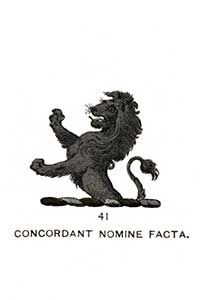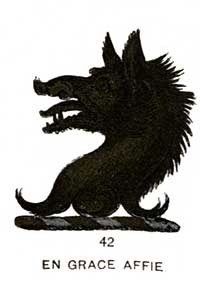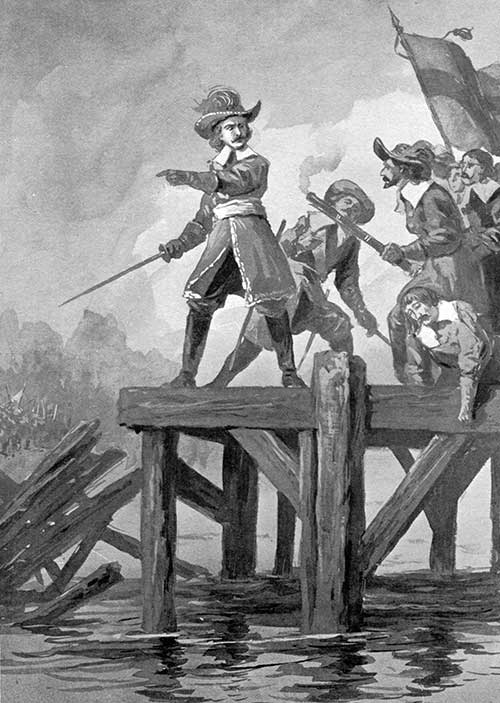The Grace Family

(Crest No. 41. Plate 66.)
THE Grace family is of Norman descent, being a branch of the Fitzgeralds. The founder of the family was Raymond Le Gros, so named from his great stature and strength. He was the son of William Fitzgerald, who was a brother of Maurice Fitzgerald, the celebrated Anglo-Norman chief who accompanied Strongbow’s expedition to Ireland, and who was the ancestor of the earls of Kildare and Desmond. Raymond Le Gros married Basilia de Clare, Strongbow’s sister, received a large grant of lands, and became Constable and Standard Bearer of Leinster, and Chief Governor of Ireland. Raymond’s son, Hamon, took the name of Le Gros, or Le Gras, and in the course of time it became Anglicized to its present form of Grace.

(Crest No. 42. Plate 66.)
The Graces became one of the most distinguished families in Leinster, and were created barons of Courtown in the County of Kilkenny, where their large territory was known as “Grace’s Country.” The family suffered much in the Anglo-Irish wars.
One of its most distinguished members was Colonel Richard Grace, son of Baron Robert Grace of Courtown. His seat was at Moyelly Castle in Queen’s County. He served in England in the cause of Charles I., and for some years afterward took part in the wars of 1641-52 in Ireland against the Cromwellians, in which he commanded some three thousand troops. His activity and daring rendered him very popular, and he was for a time one of the chief obstacles to the Cromwellian settlement. His lands were confiscated and given to one John Vaughan, and a large reward was set on his head by the English Government. After the termination of the war he entered the Spanish service with twelve hundred of his men, and afterward distinguished himself in the military service of France. He was a close friend of the Duke of York, who treated him with the familiarity of an equal rather than the reserve of a sovereign. He accompanied the latter to Spain after the alliance between England and France in 1665, and in 1658 signalized himself in the Spanish service in the battle between the Spanish and the allied English and French, at the Dunes before Dunkirk.

COLONEL RICHARD GRACE,
Defending the Bridge at Athlone.
After the Restoration he recovered a portion of his estates, and was granted a pension of four hundred pounds. He was subsequently made Governor of Athlone, in command of a garrison of three regiments of infantry, and eleven troops of cavalry by King James the Second. When the place was invested by a powerful force under Gen. Douglas, after the battle of Boyne, he destroyed the town, on the east side of the Shannon, broke down the bridge, and successfully resisted the enemy’s attack. In answer to the messenger who came to demand the surrender of the place, Grace said, as he fired a pistol shot over the messenger’s head: “These are my terms; these only will I give or receive; and when my provisions are consumed I will defend till I eat my old boots.”
Gen. Douglas was finally compelled to retire after suffering a heavy loss. Grace subsequently made a heroic defence, with an inferior force, under St. Ruth, against De Ginkell’s army, and after the citadel finally fell, Grace’s body was found buried in the ruins.
He had one daughter, Frances, of whom King James II. was godfather. She married in 1665 Robert, eldest son of John Grace of Courtown. King James had intended to reward the service of the house of Courtown by raising Robert Grace to the dignity of Viscount, but the Revolution prevented his carrying out his design.
Gerald Grace, of Ballylinch Castle, fell at the battle of Kilrush, April 15, 1642, and his estate of seventeen thousand acres was confiscated by the Commonwealth.
John Grace was the last baron of Courtown. He lost his estate of thirty thousand acres in the County of Kilkenny, on account of his fidelity to King James the Second. His son Robert died childless, and with him terminated the line of the Courtown Graces. Another branch of the family was raised to the dignity of baron, April 11, 1795. The family seat is at Boley, Queen’s County, Ireland.
Another noted personage of this family was Sheffield Grace, historiographer and linguist, born in 1788. He was a son of Richard Grace of Boley, Queen’s County, M. P. for Baltimore, County Cork. He was educated at Oxford, was a member of the Royal Society, Society of Antiquaries, and other learned bodies. He was a man of extraordinary learning, and a friend to all who sought his aid. He assisted John Banim, when the distinguished novelist was struggling for existence, and helped him into prominence. Among Grace’s publications are “Descriptive and Architectural Sketch of the Grace Mausoleum, Queen’s County;” “Memoirs of the Family of Grace” (1823), dedicated to his kinswoman, the Duchess of Buckingham and Chandos; and “An Ancient Feudal War-Song,—the Slogan or War-Cry of the Retainers and Clansmen of the Grace Family, Barons of Courtown and Lords of the Cantred of Grace’s Country, with Translations from the Original Gaelic or Iberno-Celtic Language into Metrical Versions of the English, French, Italian, German, Spanish, Greek, and Latin Languages, Selected and Composed by Sheffield Grace.”
Among the prominent representatives of this family in America may be mentioned the Hon. William R. Grace, of New York, and his brother, Mr. Michael P. Grace. William R. Grace was born in Ireland in 1833, and when a youth came to the United States, where he engaged in mercantile business. Some years afterward he founded a commercial house in Liverpool, England, and subsequently large business establishments at Callao and Lima, Peru, with branch houses in several cities of North and South America, one of the principal being that of W. R. Grace & Co., New York. The Grace firm largely controls the coast-trade between the two Americas, and has a large number of vessels constantly engaged in the trade. Mr. Grace has been connected for many years with many large commercial and financial institutions, having been President of the Export Lumber Co., Director of the Marine National Bank, the Lincoln National Bank, and the Emigrant Savings Bank, and Receiver of the Continental Life Insurance Co. Mr. Grace has also been noted for his many acts of beneficence, among which may be mentioned his contribution of one-quarter of the cargo of the U. S. S. Constellation, at a cost of $50,000, on the occasion of the Irish famine.
Mr. Grace served as Mayor of New York City from 1880 to 1883 and was afterward elected for a second term. In 1890 he effected the conversion of the Peruvian debt, a work of great difficulty and delicacy, in a manner satisfactory to that country and the bondholders.
The name is also prominently represented in the ranks of the clergy, among whom may be named the late Most Rev. Thomas L. Grace, Archbishop of St. Paul, Minn.; Rev. L. A. Grace, Niagara University; Rev. Wm. Grace, Springfield, Mass., and others.
